Ecommerce Price Optimization: 12 Pricing Strategies to Boost Revenue

“What is the right pricing for my products?” — Peter asked.
I know you came here with the same question in mind! Don’t worry, this page will help you and Peter as well.
As we all know, the wrong product pricing can affect your business revenue in two ways as given below:
- If prices are higher — you can face low conversions
- If prices are lower — you are leaving money on the table.
To resolve these issues, you need to head for “Price Optimization” which usually starts with finding the right pricing for selling your products. Wondering how to find that???
Well, that’s why we’ve prepared this comprehensive guide. Here, you can discover the best eCommerce price optimization strategies to maximize your store revenue (by balancing value with profit).
Yes, we’ll also learn what you should be optimizing for and how you can get started optimizing your pricing.
So, shall we begin with the basics?
What is Price Optimization in eCommerce?
In eCommerce, Price optimization is all about finding a sweet spot (product price) between customer demand and business profitability. It involves using data analytics and algorithms to study customer and market data and identify the optimal price point for a product.
As market conditions change and customer preferences evolve, you need to continually analyze and adjust your pricing strategy to stay competitive. It’s about understanding your customer’s willingness to pay and setting a price that satisfies both —the customer’s pocket & your business objectives.
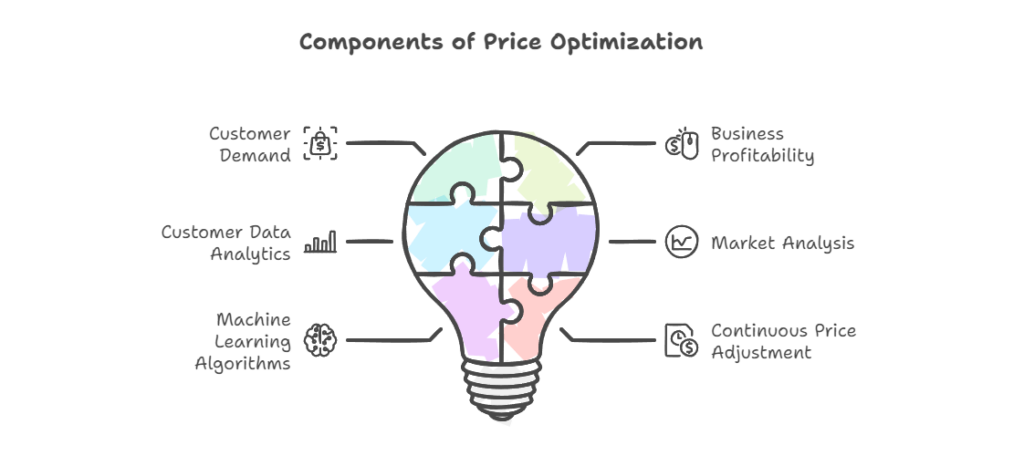
Price optimization helps you find that middle ground where everyone wins.
Here’s how it works:
Customer Demand
Your customers’ willingness to pay depends on how much they value your product. Are they looking for a bargain, or are they willing to splurge on premium quality? Understanding your audience’s buying behavior is the first step in crafting a pricing strategy that works. You can’t just assume—you need data to back it up.
Business Profitability
It’s not just about covering your costs (production, distribution, and other expenses). Pricing needs to align with your broader business objectives—whether it’s hitting profit margins or driving revenue growth. Your prices should factor in production, distribution, and the long-term value of your business goals.
Customer Data Analytics

By collecting and analyzing data on customer behavior, you can uncover insights that directly impact your pricing. Whether it’s customer surveys, past sales data, or demographic details, every piece of information helps you fine-tune your pricing to meet your audience’s needs and expectations.
Market Analysis
Your competitors aren’t standing still, and neither should you. Understanding your competitors’ pricing strategies and market dynamics can help you set competitive prices. By tracking market trends and your competitors’ moves, you can spot opportunities to either undercut or out-position them. It’s not about copying their strategy—it’s about finding where you can offer more value at the right price.
Machine Learning Algorithms
Today, machine learning and smart algorithms can process vast amounts of data—faster and more accurately than ever before. These tools help you identify the most effective pricing strategies by factoring in customer behavior, market conditions, and competitor pricing.
In short, let technology do the heavy lifting so you can focus on the bigger picture.
Continuous Price Adjustment
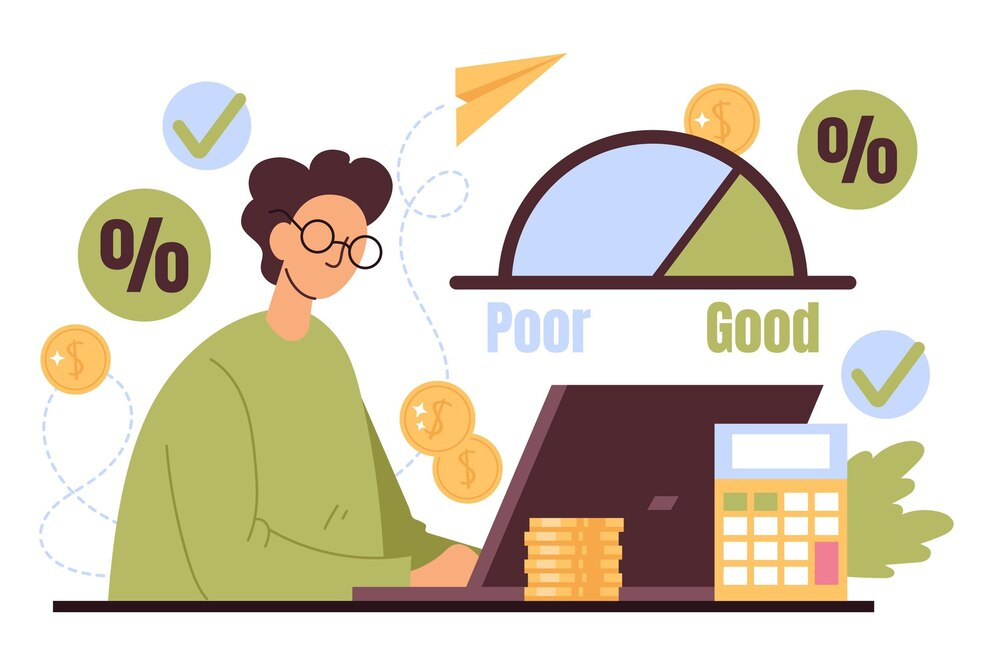
Market conditions and customer preferences can change rapidly. Therefore, it’s important to regularly review your pricing strategy and make adjustments as needed. This can involve raising or lowering prices, offering discounts or promotions, or implementing dynamic pricing strategies.
Even after understanding the importance of pricing optimization, most eCommerce brands fail at pricing. Let’s know why!
Why Are Most Companies So Bad at Pricing?
Pricing is tough. Even the most successful companies struggle with getting it right, and it’s not because they aren’t trying. The reality is, most businesses miss the mark on pricing, and it often leads to missed revenue opportunities or profit losses. But why? What makes pricing so challenging?
Let’s break down the top reasons why so many companies fail at pricing, and more importantly, how you can avoid these pitfalls.
1. They don’t spend enough time on pricing strategy
Most companies just slap a price on their products without giving it much thought. They think it’s as simple as adding up their costs and adding a profit margin. But it’s not that easy. The biggest mistake companies make is not dedicating enough time to their pricing strategy.
Pricing is a complex strategy that requires careful consideration of many factors, such as customer demand, competition, and business goals.
Solution: Take the time to research your market, analyze customer behavior, and align your prices with both short-term revenue goals and long-term brand positioning.
2. They rely on guessing and discounts
A lot of companies rely on guesswork when it comes to pricing. They might just throw a dart at a board and see where it lands. Or they might offer discounts all the time, thinking that’s the only way to get people to buy their products.
While discounts can bring in quick sales, they can also eat away at your profit margins and train customers to wait for the next markdown. Frequent discounts also make it harder to raise prices later, as customers become conditioned to expect bargains.
Solution: Instead of guessing or relying on discounts, base your prices on customer data and market trends. Use tools and analytics to determine the right price points that align with your value proposition.
3. They neglect value-based pricing
A big mistake is focusing only on costs instead of the value your product delivers.
Too many businesses get stuck in a “cost-plus” mindset. They think, “If it costs me $20 to make, I’ll just add a 50% markup and sell it for $30.”. However, pricing based solely on cost overlooks one key factor—the value your product delivers to the customer.
If your product solves a major problem or has unique features that competitors don’t offer, you’re likely leaving money on the table by not charging more. Customers don’t just buy products—they buy solutions, experiences, and benefits.
Solution: Shift your focus to value-based pricing. Ask yourself, “What is this product worth to the customer?” When you start pricing based on value, you can justify higher prices because you’re selling the benefits, not just the product.
4. They don’t localize pricing
Here’s another mistake: One-size-fits-all pricing. Many companies set the same price for their product across all markets, without considering local factors like purchasing power, market competition, or cultural preferences. What works in one country might not work in another.
For instance, a product that’s seen as a premium item in the U.S. might need to be priced differently in emerging markets where customers have different spending habits.
Solution: Localize your pricing by analyzing each market individually. Consider local purchasing power, taxes, and cultural factors that might influence how much customers are willing to pay. Customized pricing shows that you understand your market and are willing to meet customers where they are.
If you want to be successful in eCommerce, you need to take pricing seriously. It’s not something you can just wing it. You need to develop a well-thought-out pricing strategy and stick to it.
Let’s finally explore all the best eCommerce price optimization strategies that can help you unlock higher business profits.
What are Price Optimization Strategies for Better Revenue?
Finding the perfect price for your products is like unlocking the door to growth. These strategies will help you identify the right product pricing. And, once you find the right price, everything becomes easier, from sales and marketing to growth and profitability.
So, what are the strategies that can help you reach that ideal price point? Let’s explore the proven pricing strategies that can drive better revenue.
1. Dynamic Pricing
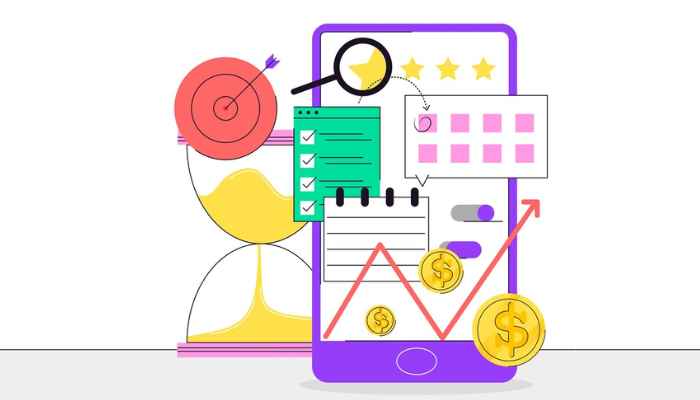
We can resemble dynamic pricing like surfing a wave—you adjust your prices based on the market conditions around you. It’s all about flexibility. Dynamic pricing allows you to make the most out of high-demand periods while staying attractive during slow times. Factors like demand, location, and even the time of day can influence what customers are willing to pay.
Airlines and hotels do this all the time. Prices go up during peak seasons or when seats and rooms are in high demand.
For eCommerce, this means you can tweak your product prices based on factors like customer behavior, competitor pricing, or market conditions. If demand spikes or supply runs low, you can increase prices to maximize revenue. On the flip side, during slower times, offering a discount can help clear inventory and attract price-sensitive customers.
2. Bundle Pricing
Bundle pricing is all about offering a group of products or services at a discounted rate, rather than selling each item separately. You can pair complementary products that make sense together, and offer a discount that’s attractive but still profitable for your business.
Why does this work? Customers feel like they’re getting more for their money, and you benefit by increasing the average order value. Plus, bundling often encourages customers to try products they may not have purchased on their own, which leads to more long-term sales.
For example, if you sell skincare products, you could bundle a cleanser, toner, and moisturizer into one package at a lower price than if they were bought individually.
3. Value-Based Pricing

Value-based pricing means setting your price based on the perceived value of your product, not just the cost of production. If your product solves a big problem or has unique features that customers find valuable, you can charge more.
How to use it effectively:
- Understand what your customers value most about your product.
- Conduct surveys, read reviews, and analyze why people choose your product over others. This helps you set a price that reflects its true worth in the eyes of your customers.
For example, if you sell high-quality eco-friendly shoes, your customers may be willing to pay a premium because they care about sustainability and the superior materials you use. They’re not just buying shoes—they’re supporting a cause and getting a product that lasts longer.
4. Competitive Pricing
Competitive pricing is exactly what it sounds like—monitoring what your competitors are charging and adjusting your prices accordingly. This strategy works well in markets where similar products exist, and customers can easily compare prices.
For example, in the tech industry, where dozens of companies may offer similar products, it’s essential to keep an eye on competitor prices. If your prices are too high, you risk losing customers to cheaper alternatives. If they’re too low, you may be undervaluing your product and cutting into your profits.
Here, you’ve to regularly check what your competitors are charging and why. If they’re offering lower prices, what’s the trade-off? Are they sacrificing quality? Ensure your prices reflect the quality and value you offer, and don’t be afraid to stand firm if your product justifies a higher price.
5. Penetration pricing
When you’re launching a new product, penetration pricing can help you break into the market. The idea is simple: set your prices lower than your competitors to attract price-sensitive customers. This is especially useful if you’re entering a crowded market where customers are looking for the best deal.
Once they’re hooked on the product, you can gradually increase prices as you build brand loyalty. While it’s great for attracting new customers, make sure you have a plan in place for how and when you’ll raise prices. You don’t want to create an expectation of low prices forever.
6. Personalized Pricing
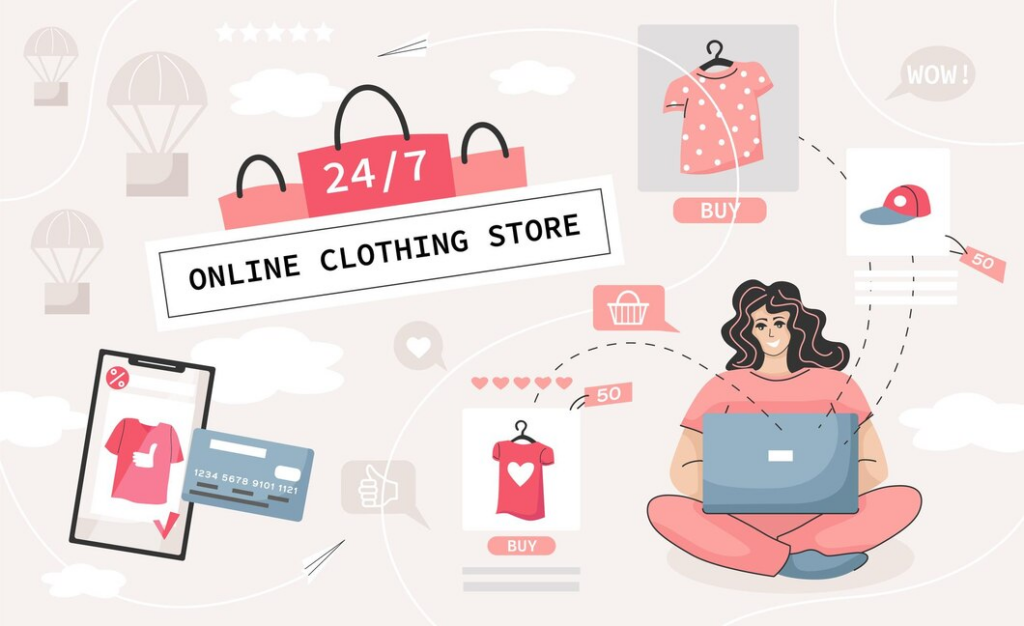
Personalized pricing involves using customer data to tailor prices to each individual based on their behavior, shopping habits, and even their loyalty to your brand. By analyzing customer data—such as their purchase history, browsing behavior, and engagement with your site—you can create personalized offers that feel tailored to each shopper.
For example, an online beauty retailer might offer returning customers personalized discounts based on their previous purchases. A customer who frequently buys skincare products could receive a special offer on a complementary item, which encourages them to spend more.
This makes customers feel valued, boosting loyalty and driving repeat purchases. Personalized pricing also helps in customer retention, reducing churn by rewarding your most valuable customers.
Pro Tip: You can use tools like dynamic pricing algorithms or customer segmentation to offer targeted discounts, tiered pricing, or special offers based on individual shopping patterns.
7. Loss Leaders Pricing

Loss leader pricing is a strategy where you sell certain products at a price below their cost to attract customers. The idea is to get shoppers through the door (or in your case, onto your website), where they’ll hopefully add more items to their cart—items that do generate profit.
Suppose you’re running an online electronics store. You could sell popular products like smartphone cases or USB cables at a loss—let’s say 30% below your cost of production. These are small-ticket items, but they draw in customers because they appear as unbeatable deals. However, the real game happens once they’re browsing your site. While there, they’re likely to pick up higher-margin items like wireless headphones or phone chargers, where your profit margins are healthier.
In marketplaces like Amazon, you might have noticed extremely low prices on certain items (like $10 smart home devices), but once a customer is on the site, they’re more likely to add higher-margin products, which balances out the initial loss.
The key to success with loss leader pricing is to ensure you’ve optimized your upsell and cross-sell tactics. Offering related products, bundles, or premium versions can turn a loss into a profitable sale in the long run.
8. Subscription Pricing
Subscription pricing is a powerful way to create recurring revenue streams and improve customer retention. Instead of selling a product once, subscription pricing allows customers to subscribe to access your products or services on a regular, recurring basis—monthly, quarterly, or annually.
Subscription pricing works especially well for products that people use regularly, such as personal care items, pet supplies, or even digital services like software and online courses. It also reduces churn because customers are often locked into longer-term commitments, and reduces their chances to switch to competitors.
9. Clearance Pricing
Sometimes, it’s better to clear out old inventory rather than let it sit and collect dust in your warehouse. Clearance pricing is a strategy where you discount products to sell them quickly, typically due to excess inventory, seasonal changes, or product discontinuation. The goal is to free up space, recoup some costs, and make room for newer, higher-margin items.
Let’s say you run an online clothing store. At the end of each season, you might have leftover stock—last season’s jackets or summer dresses. Instead of letting that inventory take up valuable space, you can offer steep discounts to move the products quickly. These markdowns can draw price-conscious shoppers who are looking for a bargain, while you clear the way for next season’s inventory.
Fashion retailers like ASOS are known for running end-of-season clearance sales.

They’ll slash prices on products that are out of season to move stock quickly and make room for new collections. Customers flock to these sales for deep discounts, while the company keeps inventory flowing and avoids excess stock.
Clearance pricing isn’t just for fashion—it works in any e-commerce business with products that have a shelf life, including electronics, home goods, and even food items. The trick is to time your clearance sales correctly and promote them effectively so you don’t end up with dead stock.
10. Economy Pricing
Economy pricing is all about offering products at lower prices by keeping production and operational costs down. This strategy is ideal for businesses selling everyday essentials where price sensitivity is high, and margins may be slimmer, but volume is the key to profitability.
Let’s consider budget-friendly online retailers like Amazon Basics. They offer a wide range of products, from office supplies to household items, at lower prices compared to premium brands. By streamlining operations, cutting out unnecessary features, and selling in bulk, they manage to keep costs low, making their prices highly competitive.
When consumers are price-sensitive or shopping for necessities, economy pricing can attract a large customer base. By minimizing production costs and passing the savings to customers, businesses can increase their market share while still turning a profit through higher sales volumes.
11. Cost-plus Pricing

Cost-plus pricing is one of the most straightforward pricing strategies. It involves adding a specific markup percentage or dollar amount to the cost of producing a product. This ensures that your prices cover both your production costs and give you a margin for profit. While it’s simple, it’s not always the most optimized strategy for maximizing revenue or reflecting market demand.
Let’s say an eCommerce store sells custom T-shirts. If the production cost (fabric, printing, labor, etc.) is $10 per shirt, and the company adds a 50% markup, the final price would be $15. This method ensures the business makes a profit on every sale, but it doesn’t account for what customers might be willing to pay or how competitors are pricing similar products.
For businesses that sell standardized products or those with low market competition, cost-plus pricing ensures that you cover costs while maintaining profitability.
12. Price Skimming
Price skimming is a strategy often used when launching innovative or premium products. It involves setting a high price at the beginning when the product is new and in demand, then gradually lowering the price over time as competition increases or demand decreases. This strategy allows businesses to maximize profits from early adopters who are willing to pay a premium for exclusive access or cutting-edge features.
For example, when new smartphones or gadgets like Apple’s iPhones or Samsung Galaxy devices are released, they are initially priced at a premium. Tech enthusiasts and early adopters rush to buy them despite the high cost. After a few months, as new models or competitors hit the market, the price drops, making the product accessible to a broader audience who may have been price-conscious initially.
Price skimming helps businesses recover the development and marketing costs of new products quickly. It also captures different segments of the market, from those willing to pay a premium for early access to those who prefer waiting for a price drop.
So, you’ve got the pricing strategies and you want to maximize your sales. But which prices do you actually need to optimize? Let’s find the answer below. 👇
Which Product Prices do you need to Optimize?
It’s not just about the base price of the product itself!
Here are the three product pricing you need to optimize in eCommerce:
1. Starting Prices

This is the original price of your product, the one you set before any discounts or promotions. This is the foundation of your pricing strategy. Your starting price should reflect the value your product offers to customers.
If it’s too high, you might lose potential buyers. If it’s too low, you might not make enough profit. Optimizing your starting price is especially important for products with stable demand, like groceries or office supplies.
2. Discounted Prices
Offering discounts is a common strategy to attract new customers and boost sales. However, it’s essential to optimize these discounts to ensure they’re effective and profitable. Consider factors like the discount amount, the duration of the offer, and the target audience.
Discounts can be particularly useful for acquiring new customers, especially when used strategically.
3. Promotional Prices

These are special prices you offer for a limited time, like during a holiday season or to promote a new product. However, it’s important to optimize these promotional prices to ensure they are both effective and profitable.
When deciding on promotional prices, you need to consider a few things:
- Will the discount make you more money or less?
- How many more products will you sell because of the discount?
- How long will it take to sell the product at the discounted price?
How to Optimize your eCommerce Product Pricing?
Optimizing your product pricing in eCommerce isn’t just about guessing what customers might pay—it’s about understanding your audience and using data-driven insights to find that perfect price point.
Let’s learn how you can optimize your pricing strategy step by step.
Step 1# Gather your customer & purchase data
Before you can make any pricing decisions, you need to know who your customers are and how they behave. Start by collecting data from various sources, including:
- Customer Surveys: Direct feedback from your customers can provide valuable insights into their preferences, needs, and willingness to pay. Consider conducting surveys after purchase or sending out occasional questionnaires to gather opinions on pricing and product value.
- Website Analytics: Use tools like Google Analytics to track customer behavior on your site. Look at metrics such as page views, bounce rates, and conversion rates to understand which products attract interest and at what price points.
- Historic Sales Data: Analyze past sales records to identify trends. Look for patterns in pricing that have led to higher sales volumes or revenues. For example, do customers tend to buy more during promotions or when prices are lower?
- Customer Demographics: Gather data on customer demographics such as age, location, and purchasing power. This information will help you understand who your customers are and how their characteristics influence buying behavior.
Let’s understand with the help of an example.
Suppose you run an online store selling skincare products. You decide to gather data over a three-month period to understand your customers’ purchasing behavior better.
Table: Sample Customer Purchase Data
| Customer ID | Age | Gender | Location | Purchase Frequency | Average Order Value | Price Sensitivity (1 = low, 5 = high) |
| 001 | 25 | Female | New York | 3 | $45 | 4 |
| 002 | 32 | Male | San Francisco | 1 | $60 | 3 |
| 003 | 28 | Female | Chicago | 5 | $30 | 2 |
| 004 | 40 | Female | Miami | 2 | $55 | 5 |
| 005 | 35 | Male | Los Angeles | 4 | $50 | 3 |
This data shows varying levels of price sensitivity and purchase habits across different customers, which will be vital in future steps.
Step 2# Analyze different customer segments

Once you’ve gathered your customer and purchase data, it’s time to dig into the numbers to uncover insights that will guide your pricing strategy. This step involves interpreting the data to find patterns, trends, and opportunities that can help you optimize your prices.
Let’s break down how to analyze this data effectively and put it to work.
Your analysis should focus on several key factors that will inform how you adjust your pricing including:
- Customer Segments: Group customers by factors like price sensitivity, location, or product preferences. Each group may respond differently to price changes.
- Price Sensitivity: Identify customers who are willing to pay a premium versus those who prefer discounts.
- Product Performance: Look at which products perform best and where there’s room for improvement.
- Seasonality: Track sales patterns across different times of the year and adjust pricing to take advantage of high-demand periods.
- Competitor Pricing: Analyze competitor prices to identify opportunities to undercut or price-match.
Using the skincare eCommerce business from Step 1, let’s analyze the data to identify pricing opportunities. Here’s a simple table that shows the key data points:
Table: Sample Customer & Product Data
| Customer Segment | Top Product Purchased | Average Spend | Price Sensitivity | Purchase Frequency (yearly) | Peak Purchase Periods |
| Segment 1 (Age 25-35) | Organic Moisturizer | $85 | 2 | 4 | January, June |
| Segment 2 (Age 36-50) | Anti-Aging Serum | $120 | 3 | 3 | March, December |
| Segment 3 (Price-Sensitive) | Essential Cleanser | $45 | 5 | 2 | November, December |
From this data, we can spot three key customer segments:
- Segment 1 (Age 25-35) prefers organic products and has a lower price sensitivity (2 out of 5). This suggests that they are willing to pay for high-quality, natural ingredients. Therefore, you might consider testing a premium price increase for organic skincare lines or launching a limited-edition, higher-priced product aimed at this group.
- Segment 2 (Age 36-50) frequently purchases anti-aging products, with an average spend of $120. This segment is slightly more price-sensitive but values premium results. You could experiment with bundle pricing—offering the serum with a complementary product at a slight discount to increase the overall order value.
- Segment 3 (Price-Sensitive) consistently buys essential products like cleansers but only during promotional periods. They have a high price sensitivity (5 out of 5), so any price increases may result in fewer sales. A good approach for this segment is to offer seasonal promotions or limited-time discounts that maintain profitability while appealing to their price sensitivity.
For each segment, determine the average amount they are willing to spend and how responsive they are to changes in price.
Look at your best-selling products and analyze which segments are buying them. This can help you decide which products to increase prices on or where to bundle products to increase perceived value.
Step 3# Determine your pricing objectives
Once you’ve gathered and analyzed your customer and purchase data, the next step in optimizing your eCommerce pricing is to establish clear pricing objectives. These objectives will guide how you set, adjust, and fine-tune your product prices to align with your business goals.
There are several pricing objectives to consider, depending on your business model and long-term goals (determine which one best aligns with your overall strategy and market conditions).
1. Maximizing Profit Margins
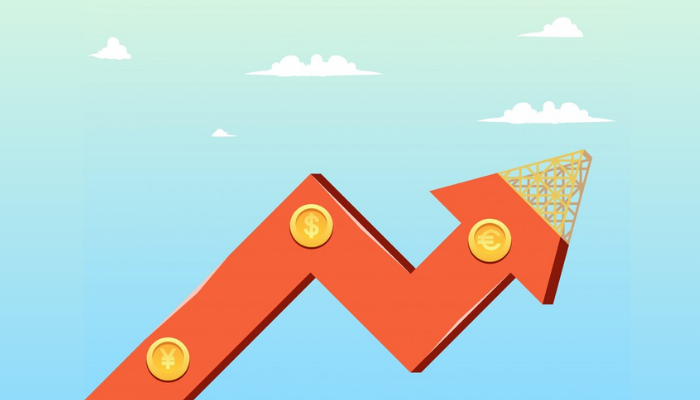
A common objective for businesses is to maximize profits by finding a price point that generates the highest possible revenue while covering costs and leaving room for a healthy margin. This approach is ideal if your products have unique value or minimal competition, allowing you to price higher without losing customers.
2. Increasing Market Share
Another objective is to gain a larger share of the market by pricing competitively. Businesses pursuing this strategy might accept lower profit margins in the short term in exchange for a higher volume of sales. This objective works well in highly competitive markets where brand awareness and customer acquisition are key.
3. Maximizing Customer Lifetime Value (CLTV)
Maximizing customer lifetime value means setting prices that not only drive immediate sales but also encourage repeat purchases and long-term loyalty. This objective is ideal for subscription-based or recurring purchase business models like SaaS platforms or beauty products with high repurchase rates.
4. Enhancing Brand Positioning
Some businesses aim to use pricing to position their brand as a luxury or premium option in the market. In this case, higher prices aren’t just about profitability—they are central to maintaining a perception of exclusivity and quality.
5. Penetrating New Markets
If your business is expanding into new geographical or product markets, your pricing objective might focus on market penetration. In this case, the goal is to set lower prices to attract new customers and establish a foothold in a market where your brand is less known.
Let’s apply these concepts to the skincare eCommerce business from the previous steps. Here’s how you might set pricing objectives based on the customer segments and data analysis we’ve already reviewed.
| Segment | Objective | Actionable Strategy |
| Segment 1 (25-35) | Maximize Profit Margins | Increase Organic Moisturizer price by 5-10%; emphasize premium product features. |
| Seg/ment 2 (36-50) | Retain and Upsell | Introduce bundles (Anti-Aging Serum + complementary products); offer loyalty discounts for repeat buyers. |
| Segment 3 (Price-Sensitive) | Increase Customer Acquisition | Offer seasonal discounts and introductory first-time buyer deals on essential products like the cleanser. |
In this step, we’ve converted customer data insights into specific pricing objectives, aligning each strategy with the characteristics and behaviors of your customer segments.
Step 4# Plan your pricing strategy

Once you’ve determined your pricing objectives, the next step is to develop a clear, actionable pricing strategy. A pricing strategy is the plan you’ll use to achieve the objectives you set in Step 3. Now we need to consider the customer segments, market conditions, and business goals, and define:
- how you will price your products over time,
- how you’ll structure promotions, and
- how you’ll handle pricing adjustments based on real-world data.
For the skincare eCommerce example, let’s explore how to plan a pricing strategy that caters to different customer segments while focusing on objectives like maximizing profit, retaining customers, and acquiring new ones.
We’ll plan pricing strategies for the three customer segments identified earlier—organic product buyers, anti-aging product buyers, and price-sensitive buyers. Each strategy will reflect the objectives set in Step 3.
1. Segment 1 (Age 25-35, Organic Product Buyers)
- Objective: Maximize profit margins by premium pricing.
- Strategy: Implement value-based pricing and premium positioning.
Premium Pricing: Since this segment is less price-sensitive and values organic ingredients, you can adopt a premium pricing model. Set the price of your Organic Moisturizer higher than average for competitors, emphasizing its natural and high-quality ingredients. For instance, increase the price from $85 to $95 to reflect the product’s perceived value.
Scarcity Tactic: Introduce limited-edition versions of the Organic Moisturizer to create a sense of exclusivity, which justifies premium pricing. For example, offer a special blend that’s only available for a limited time at a higher price point ($100).
Upselling: Bundle the Organic Moisturizer with complementary organic products, such as a toner or serum, at a bundled discount. The original price might be $150 for both, but you offer the bundle for $135, making it appealing while increasing the average order value.
| Product | Original Price | New Price | Bundled Price | Premium Version Price |
| Organic Moisturizer | $85 | $95 | $135 (with toner) | $100 |
2. Segment 2 (Age 36-50, Anti-Aging Product Buyers)
- Objective: Retain customers and increase order value through bundling and loyalty rewards.
- Strategy: Focus on customer retention and loyalty through bundle pricing and subscription models.
Bundle Pricing: Offer bundles that include high-demand products such as the Anti-Aging Serum paired with an eye cream. This could increase the total order value while providing perceived savings to the customer. For example, if the serum is priced at $120 and the eye cream at $60, offer the bundle for $165 instead of $180.
Loyalty Programs: Introduce a loyalty program that rewards customers with discounts after multiple purchases. For instance, customers who purchase the Anti-Aging Serum three times receive a 10% discount on their next purchase. This helps retain high-value customers.
Subscription Pricing: Offer a subscription model for recurring purchases of the Anti-Aging Serum at a slightly lower price. If a one-time purchase is $120, offer a subscription at $110/month, encouraging long-term commitment and increasing lifetime customer value.
| Product | Original Price | Bundle Price | Loyalty Discount | Subscription Price |
| Anti-Aging Serum | $120 | $165 (with eye cream) | 10% off after 3 purchases | $110/month |
3. Segment 3 (Price-Sensitive Buyers)
- Objective: Increase customer acquisition and stimulate purchases through discounts and promotions.
- Strategy: Use competitive pricing, seasonal discounts, and introductory offers to attract price-conscious buyers.
Competitive Pricing: For products like the Essential Cleanser, price competitively to attract this segment. Set prices slightly lower than competitors without sacrificing quality perception. For example, price the Essential Cleanser at $19.99, while competitors may price similar products at $22.99.
Introductory Offers: Attract new customers with a first-time buyer discount. For instance, offer 20% off their first purchase of the Essential Cleanser, reducing the price to $15.99. This lowers the entry barrier for new buyers and increases customer acquisition.
Seasonal Promotions: During peak buying seasons (like Black Friday or holiday sales), offer deeper discounts on popular products like the Essential Cleanser. A 25% holiday discount could drop the price to $14.99, driving significant sales volume during key shopping periods.
| Product | Original Price | Competitor Price | Introductory Offer Price | Seasonal Discount Price |
| Essential Cleanser | $19.99 | $22.99 | $15.99 (20% off) | $14.99 (25% off) |
In this step, we’ve crafted a comprehensive pricing strategy for each customer segment based on clear objectives.
Step 5# Adjust pricing and monitor changes
After implementing your pricing strategy, the final step in optimizing your eCommerce product pricing is to adjust your prices over time and monitor the impact of these changes. Pricing optimization is not a one-time task; it requires constant evaluation and fine-tuning to keep pace with shifting market dynamics, customer preferences, and competitive pressures.
In this step, we’ll explain how to monitor the success of your pricing strategy, use data to make necessary adjustments, and provide examples of how to do this in your skincare eCommerce business.
Let’s continue using the skincare eCommerce example with the same three customer segments—organic product buyers, anti-aging product buyers, and price-sensitive buyers.
After raising the price of the Organic Moisturizer for Segment 1, you notice a slight drop in sales. You run an A/B test by bundling it with a toner and discover that bundled pricing significantly increases conversions, even at the higher price point.
For Segment 3, you offer an introductory discount during the holiday season and track the resulting spike in sales. Based on this, you plan to continue offering limited-time discounts to attract new customers during peak shopping periods.
Hope this guide helped you find the answers to your questions. But I believe you might have some more in your head.
Let’s tackle thoes unanswered questions below.
E-commerce Price Optimization FAQs
How is pricing done in e-commerce?
Pricing in e-commerce is done by using a combination of strategies, including cost-plus pricing, value-based pricing, competitive pricing, and dynamic pricing. Businesses consider factors like production costs, competitor prices, customer demand, and perceived value. Additionally, e-commerce companies often use data analysis and market trends to adjust prices in real-time, ensuring profitability while staying competitive.
What are the 5 common pricing strategies?
Here are the 5 common pricing strategies:
- Cost-Plus Pricing: Adding a fixed percentage markup to the product cost.
- Competitive Pricing: Setting prices based on competitor offerings.
- Value-Based Pricing: Pricing based on the perceived value to the customer.
- Dynamic Pricing: Adjusting prices in real-time based on demand, competition, and other factors.
- Penetration Pricing: Setting a low price to enter the market and attract customers quickly.
Each strategy helps eCommerce businesses optimize prices to meet market demands and maximize profitability.
What is the pricing strategy of e-commerce?
An e-commerce pricing strategy is a plan to accurately price products to increase sales and profits while remaining competitive. The best strategy depends on many factors, including Product type and demand, Competition, Business model, and Cost changes
What are the 3 C’s of pricing strategy?
The 3 C’s of pricing strategy are cost, competition, and customers:
- Cost: Consider all costs associated with offering the product, including development, production, distribution, storage, advertising, and manpower.
- Competition: Analyze your competitors’ products, brands, and prices.
- Customers: Research consumers’ wants and needs, and their perceptions of the value of your brand and products.
The 3 C’s model aims to help companies develop a competitive advantage by offering more value than their competitors at a lower cost.
What is Amazon’s pricing strategy?
Amazon’s pricing strategy is centered around competitive pricing, dynamic pricing, and customer-centric approaches. The company uses algorithms to adjust prices frequently based on market demand, competitor prices, and customer behavior. Amazon also focuses on
- offering low prices to attract and retain customers,
- utilizing promotional discounts, subscription services (like Prime), and
- value-added services to enhance customer loyalty.
Final Thoughts!
As we wrap up this journey through price optimization, let’s take a moment to reflect.
Just like Peter, many eCommerce merchants struggle with the dual challenges of pricing too high and risking low conversions or pricing too low and missing out on potential revenue. And now, armed with actionable strategies, you’re ready to tackle it head-on.
So, what’s next? It’s time to put these strategies into action!
- Start by analyzing your customer data to identify potential pricing opportunities.
- Experiment with personalized offers and monitor how they impact sales.
- Dive into your inventory and decide which products could benefit from clearance pricing.
And don’t forget, this isn’t just about setting prices; it’s about creating value for your customers. When they feel like they’re getting a good deal, they’re more likely to come back for more. Plus, with every successful sale, you’re not just growing your revenue—you’re building a relationship that can last for years.
Now, we’d love to hear from you! What pricing strategies are you excited to implement? Have you tried any of the strategies we discussed?
Share your thoughts in the comments below or contact us if you need further guidance.






Post a Comment
Got a question? Have a feedback? Please feel free to leave your ideas, opinions, and questions in the comments section of our post! ❤️